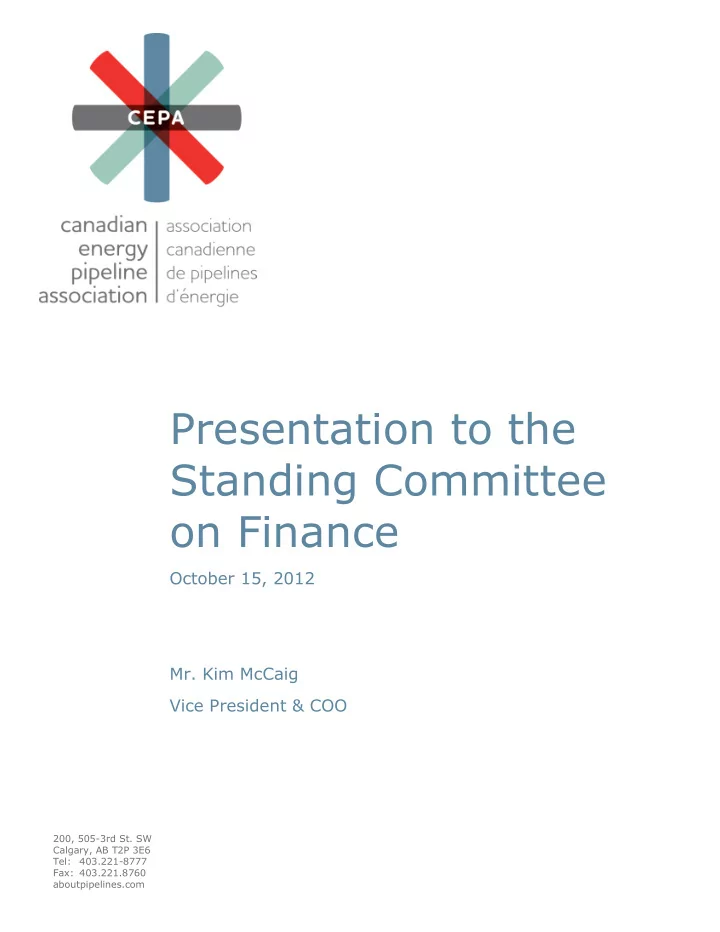

Presentation to the Standing Committee on Finance October 15, 2012 Mr. Kim McCaig Vice President & COO 200, 505-3rd St. SW Calgary, AB T2P 3E6 Tel: 403.221-8777 Fax: 403.221.8760 aboutpipelines.com
Speaking Notes: Standing Committee on Finance Mr. Kim McCaig, Vice President & COO Thank you and good afternoon. It is a pleasure to appear before you to share some of the views of the Canadian Energy Pipeline Association and I look forward to answering your questions. CEPA represents companies that transport 97 per cent of the oil and natural gas produced and used in Canada. Our membership currently operates more than 110,000 km of pipelines in Canada, transporting over 3.2 million barrels of oil and 14.6 billion cubic feet of gas every day, while employing over 8,000 full time employees. Pipelines are the only feasible, and the safest, means of transporting large volumes of crude oil and natural gas over land. In delivering Budget 2012, Minister Flaherty acknowledged that the natural resource and energy sector “are driving economic gr owth across the country. They are creating good jobs not only directly but also indirectly, in manufacturing, clerical work, skilled trades, and financial services. Canada’s resource industries offer huge potential to create even more jobs and growth, now and over the next generation.” The Responsible Resource Development provisions of Budget 2012 put in place the enabling conditions to realize these opportunities. CEPA has been a strong supporter of the objective behind regulatory reform – namely improving the efficiency of, and environmental outcomes from, environmental assessment. The proposed process reduces duplication, ensures timeliness, and maintains or improves environmental standards by focusing assessments on major environmental concerns and avoiding significant adverse effects. Our recommendations for the 2013 Budget speak to the next steps in this process, and they fall into two intrinsically-related categories – ensuring regulatory effectiveness and pipeline safety performance. Regulatory Effectiveness CEPA’s recommendation with respect to regulatory effectiveness is that the federal government commit sufficient resources to implement the changes set in motion, as well as monitor their success. Bill C-38 changed the legislative framework for the review of major projects in Canada, but policy and regulatory work still needs to be completed to support these changes. Continuing the regulatory reform process will ensure that through timely, efficient and predictable processes, investments can be made with confidence, and that strategic scrutiny and clear outcomes will ensure environmental protection. Pipelines currently transport approximately $125-billion in oil and gas at a cost of $5-billion a year, pipeline transportation provides a value-add of approximately $120-billion to the Canadian economy. Given current plans for expansion, the industry is in a position to add even more value, provided it can get the planned- for infrastructure built. 1 aboutpipelines.com
Safety Integrally related to regulatory efficiency is pipeline safety, as it is the safety performance of our industry that is a key component in maintaining our social license to operate. Safety is the top priority for pipeline companies in all aspects of pipeline development and operation, and industry is taking a leadership role in these efforts. In 2011, CEPA members spent more than 600 million dollars on monitoring and maintenance activities to ensure the safety of their pipelines. Extensive regulatory tools exist today to support and address pipeline integrity, including construction standards, maintenance, audits and regulatory powers for shut down and investigation. However, Canada does not currently have the means to require and enforce the physical protection of pipelines from the activities of others. Damage to pipelines from third parties is where we face the biggest risk. Experience in other countries shows that lives are saved where laws and enforcement are in place, including requirements for mandatory one call in all jurisdictions and administrative penalties for the enforcement of rules. CEPA appreciates the efforts to date to both introduce administrative monetary penalties and increase pipeline inspections, which along with transparent enforcement tools, including escalating fines and mandatory one call, is a key part of the solution. Conclusion Canada has been fortunate in weathering the economic troubles that have challenged the rest of the world. This is due in large part to the role that the resource and energy industry has played. The process set in motion by government to reform the regulatory system, is important to ensure Canada can retain and attract the investment necessary to develop pipeline infrastructure. This infrastructure will support growth in the natural resource sector and the diversification of Canada’s markets. Commitments by the federal government to ensure that the regulatory reform process is effectively and fully implemented to deliver better environmental outcomes, and that the regulators have the necessary tools to keep pipelines safe, are important steps to make this happen. 2 aboutpipelines.com
Recommend
More recommend